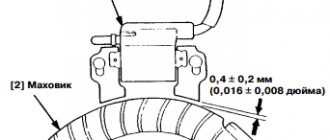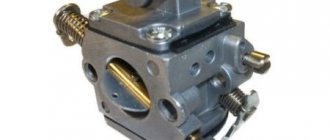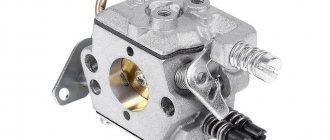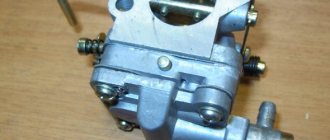Stand-alone generators are often indispensable, and the full list of their possible uses is very long - from providing electricity for a weekend beach party to constant operation at a private building. The wide range of work performed has given rise to a large number of types of autonomous generators, differing both in design and in characteristics. What they have in common is the principle of operation - an internal combustion engine of one type or another rotates the shaft of an electric generator, converting mechanical energy into electrical energy. The most obvious division of groups of generators is into professional and household.
- A household generator is, as a rule, a portable unit with a gasoline engine, not intended for long-term operation, and having a power of several kVA.
- Professional generators have increased power and continuous operation time, and for greater fuel efficiency and increased service life, diesel engines are usually installed on them. At the same time, if household electric generators produce single-phase current with a voltage of 220 V, then professional generators are overwhelmingly three-phase, designed for 380 V output voltage. Large dimensions and weight force either placing powerful generators on a wheeled chassis or making them stationary.
So, in this classification we have already discovered a number of design differences. Let's look at them in order.
Engine
As you know, a gasoline engine can operate on both a two-stroke cycle and a four-stroke cycle. At the same time, low efficiency and limited service life make two-stroke engines not the best choice for driving an electric generator, although they are simpler in design, and therefore cheaper and lighter.
A four-stroke engine, although it is more complex and more expensive, consumes significantly less fuel and can last much longer. Therefore, generators with a power of up to 10 kVA, as a rule, are equipped with engines of this type.
Gasoline engines of electric generators are mainly single-cylinder units with forced air cooling; the combustible mixture is prepared using a carburetor. To start them, either a cable starter is used, or an electric start is additionally included in the design (then, in addition to the battery, such generators also have a 12 V output: the battery is charged from this circuit and consumers designed for low-voltage power can be connected to it). The most common are engines with a cast iron liner and an overhead valve timing mechanism - as a rule, these are Honda GX engines and their Chinese copies.
The engines of household gas generators are not designed for long-term continuous operation. Exceeding the operating time specified in the operating instructions (usually no more than 5-7 hours) will reduce the life of the motor.
However, even the most advanced gasoline engines have a limited service life: with proper care, they will work for 3-4 thousand hours.
Is it a lot or a little? When used occasionally on the road, for example, to connect a power tool, this is a fairly large resource, but constantly powering a private house from a gas generator means rebuilding its engine every year. Diesel power units have a significantly longer service life; in addition, they are more profitable during long-term operation due to their greater efficiency. For this reason, all powerful generator sets, both portable and stationary, use diesel engines.
For such units, a number of disadvantages of diesel engines compared to gasoline engines (high cost, greater weight and noise) are not fundamental; there is a certain inconvenience only when starting diesel engines in cold weather.
When operating a diesel generator, it must be taken into account that prolonged idling without load is harmful for them: the completeness of fuel combustion is disrupted, which leads to increased formation of soot, clogging the exhaust, and dilution of the engine oil by diesel fuel seeping through the piston rings. Therefore, the list of routine maintenance for diesel power plants must include periodically bringing them to full power.
In addition, there are generators that run on natural gas. Structurally, they are no different from gasoline engines, except for the power supply system: instead of a carburetor, they are equipped with a reducer to regulate gas pressure and a calibrated nozzle that supplies gas to the intake manifold. Moreover, such generators can use not only a liquefied gas cylinder as a fuel source, but also a gas network - in this case, fuel costs become minimal. The disadvantage of such generators is low mobility (the gas cylinder is larger and heavier than the gas tank, which, moreover, can be refueled right on the spot), as well as an increased fire hazard, especially if used improperly. However, as a source of backup power in a house connected to a gas main, this is a good option: there is no need to worry about maintaining the level and quality of fuel in the gas tank, and the engine life when running on gas is longer than when running on gasoline.
In what cases is it necessary to regulate?
The above consequences can be prevented by adjusting the speed. You can determine that this is exactly what the problem is by the characteristic signs, which include:
- Difficulty starting both hot and cold generators.
- A sharp loss of power at idle, which is corrected by the throttle valve.
- Dark smoke from the exhaust pipe, present even in warm weather.
- Black and loose carbon deposits that form on spark plugs.
Electric generator
This is the main component of the gas generator, which determines its characteristics and scope of application. The principle of its operation is to excite current in a stationary stator winding by an alternating magnetic field created by a rotating winding (rotor) in synchronous generators or a permanent magnet in asynchronous generators. In this case, the number of stator windings determines the number of phases at the output:
- Single-phase generators have one power winding; this circuit is common in household generators of small and medium power;
- Three-phase generators have three power windings and can power both a load designed for a three-phase power supply of 380 volts, and single-phase consumers (in this case, with such a circuit, they must be distributed among three groups of equal power).
The power of the generator is closely related to both the number of phases and its general design:
- Low-power generators (up to 2 kVA) are lightweight gasoline units not intended for professional use. Their typical application is to provide energy to street retail outlets;
- Medium power generators (up to 6.5 kVA) are equipment belonging to the semi-professional and professional classes, but at the same time they are quite compact. Gasoline engines are also used. Such a generator can power a garage workshop or small house;
- Among high-power units (up to 15 kVA), you can find both gasoline and diesel ones, often having more than one cylinder. High power makes it impractical to use a single-phase circuit, so such generators often have a three-phase 380 V output, and more powerful generator sets are produced exclusively three-phase.
In addition to the high-voltage winding, many generators are equipped with an additional one, which, through a rectifier, powers consumers designed for 12 V DC: safe carriers, car compressors, and so on.
The type of excitation of the generator depends on its power and application. Asynchronous generators are much simpler and cheaper than synchronous ones due to the absence of an excitation winding and a brush assembly, and their service life is longer. On the other hand, synchronous generators by changing the winding current make it possible to easily and accurately regulate the output voltage, and also work much better with sudden changes in load, especially those with high inductance - for example, when connecting a powerful electric motor, the magnitude and duration of the voltage drop will be higher for an asynchronous generator. For this reason, gas generators made according to an asynchronous circuit are often equipped with a special starting booster system, which briefly increases the power output by the generator.
The operating principle of an asynchronous generator is shown in the video
There is another important parameter of alternating current that should not be forgotten - its frequency. And if for a number of consumers, like incandescent lamps, it is not of great importance, then for power supplies of electronic devices, a deviation of the frequency of the supply voltage from the nominal one is fraught not only with disruption of their operation, but also with damage.
The frequency of the current supplied by the generator is determined by two parameters: the rotor speed and the number of poles on it. Thus, to create a current with a frequency of 50 Hz, a two-pole rotor must rotate at a frequency of 3000 rpm, and a four-pole rotor must rotate at 1500 rpm. Maintaining the set speed is ensured by a mechanical regulator that controls the carburetor throttle valve on gasoline generators or the high-pressure fuel pump on diesel generators. This mechanism is simple and quite effective at a constant load, while with a sharp change in current consumption, the frequency changes for a short period of time. In addition, the need to maintain a constant frequency forces the generator engine to constantly operate at the same speed of maximum power, although with low energy consumption the engine could provide power at lower speeds - hence a decrease in engine life and increased fuel consumption.
These shortcomings were avoided with the widespread availability of powerful switching electronics, which made it possible to create inverter generators. The operating principle of a power inverter is simple: the alternating current generated by the generator is rectified, after which it is converted by the electronic unit back into alternating current, but at a strictly specified frequency. This makes the frequency of the output voltage absolutely independent of the rotation speed of the generator rotor, and therefore allows the engine to change speed depending on the load, saving resource and fuel.
Cheap inverters, as a rule, can produce a voltage that is far from an ideal sine wave. Connecting a powerful inductive load to such an inverter will lead to overheating and possible damage to the inverter power stage!
Inverter generators also have certain disadvantages: due to the presence of an electronic unit, they are more expensive than conventional gas generators, and are also theoretically less reliable.
In addition, the possibilities of power electronics are not limitless, and the maximum power of inverter generators now does not exceed 7 kVA. The video shows the device of a gas generator using the example of a model of the Zubr brand
Operating principle of the regulator
According to the principle of operation, the regulator included in the design of the gas generator is in many ways similar to a similar device as part of ordinary internal combustion engines . Its shaft is driven by a similar part of the engine itself. If the load decreases, the number of revolutions increases on both shafts. When the centrifugal force exceeds the resistance of the spring, which presses the lever arm against the sliding clutch, the latter moves and closes the throttle valve.
As the load increases, the speed decreases and the centrifugal force of the loads decreases. In this situation, the spring moves all components in the opposite direction and the throttle valve closes. The beginning of the regulator's action is determined by the degree of elasticity of the spring.
If it is necessary to adjust the speed, then the essence of this procedure is to increase or decrease the tension.
Generator selection
When choosing a generator, you need to start by determining the required power.
This question is not as simple as it seems, since consumers in alternating current circuits have both active (ohmic) resistance and reactive (capacitive and inductive), and often before reaching the operating mode they have energy consumption significantly higher than the nominal one. The simplest example: we need a portable generator from which we will power an 800 W rotary hammer. Its electric motor has a significant inductive component of resistance, which, when calculating energy consumption, is described by the so-called power factor, denoted as cosφ. If for a load that does not have reactance it is equal to unity, then it increases with increasing capacitance or inductance of the load. In addition, we must not forget that the generator itself has significant inductance.
It is precisely because of the inductive resistance of the generator windings that its power is indicated not in watts, but in volt-amperes at a given power factor: for example, a 5 kVA gas generator with its own cosφ = 0.8 actually has a maximum power of 4 kW.
Thus, if it is necessary to power an 800-watt electric motor with its own cosφ = 0.5, we will need a generator capable of delivering a power of 1600 W for a long time, that is, its peak power, indicated in the characteristics, should be one and a half to two times greater.
Taking into account the losses in the generator itself, for our hammer drill we will have to purchase a 4 kVA gas generator. At the same time, if we need to power lighting and an electric heater (consumers that have no reactance) from the same generator, their total power can be twice as large with the same load on the generator itself.
Next, we will determine the operating time of the generator. As already mentioned, for long-term operation, a diesel power unit is preferable - therefore, when considering a unit for constantly supplying energy to a building (private house or small workshop), it is worth considering this option, especially taking into account the above-described calculation of the required generator power - a gasoline unit will be too voracious. Since it will be impossible to constantly monitor a long-running generator, it must be equipped with a protective device that shuts down the engine when the engine oil level or pressure drops.
In some cases (the need for frequent transportation, especially manual transportation), the lighter weight of a gasoline generator may be a more important factor than the efficiency of a diesel one. Also, a gasoline unit is a more preferable option for short-term use - in this case, efficiency and resource play a much smaller role than the price of the unit itself.
To provide emergency power to your home, it is worth considering the option of connecting a generator designed to use natural gas to the gas network.
What will you need?
To adjust the speed correctly, you must have special knowledge and experience . The absence of these most likely leads to serious consequences that adversely affect the functioning of the gas generator.
If the person who is about to make the adjustment has an understanding of this process and its consequences, he will be able to perform the necessary actions using:
- A tester that is designed for frequency measurements.
- Long Phillips screwdriver.
Many people think that adjusting the speed requires disassembling the gas generator.
This opinion is erroneous, since to obtain a positive result you only need to have access to a few screws.
Launch
The portable generator must be placed on a flat, dry surface, and if working in an open space, it must be protected from precipitation. Since single-cylinder engines used in gasoline-powered generators are characterized by a high level of vibration, foreign objects, and especially fuel containers, should not be placed on the generator to avoid them falling. Before starting, you must make sure that the engine oil level is sufficient and, if necessary, add it, after which the generator engine can be started.
The load can be connected to the generator only after the engine has been started. Do not run the generator while electrical appliances are connected to it.
To start a gasoline engine, a special air damper is used, which enriches the fuel mixture in the closed position.
When starting the engine for the first time, especially in cold weather, it is necessary to close it more, the lower the air temperature, and gradually open it as the engine warms up. A warm engine should start without closing the throttle, otherwise you should pay attention to the carburetor adjustments. Starting, depending on the design of the engine, is carried out either by a cable starter (pull it out smoothly until you feel resistance, then sharply increase the force) or electric (to start, press and hold the start button). Starting a diesel engine differs only in that there is no need to use the air damper, but instead you need to slightly open the decompressor - a device that reduces the pressure in the combustion chamber to facilitate cranking during startup. In addition, starting a diesel engine can be made very difficult by an airy fuel system (the first start of a new generator or if the tank was previously run dry). In this case, you will have to bleed the fuel system (the bleeding procedure differs for different engines and is described in the operating manual).
After letting the generator run for some time (in the warm season, the gasoline engine will warm up quite quickly, no more than a minute), you can connect the load, making sure that the performance indicators or voltage indicator of the generator set indicate its full functionality.
Possible errors and nuances
Many buyers want to achieve ideal operation from their equipment through different settings and speed adjustments. They should know that if the generator starts normally, operates stably and withstands load changes stably, then there is no need to look for ways to improve operation. This can lead to malfunction and failure of important components.
Do not attempt to adjust speed or make other adjustments without knowledge and experience .
A person who does not have a detailed understanding of the design features is likely to cause damage to the device.
Maintenance
Timely maintenance of the generator set has a noticeable impact on its service life.
The engine, as its most complex component, requires the most frequent attention. According to the frequency specified by the manufacturer, indicated in operating hours, it is necessary to change the engine oil and service the air filter. On powerful generators equipped with more complex engines, the oil and fuel filters are also changed. Gasoline and diesel engines (gas engines are much less common) require replacement of spark plugs. If the generator is used sporadically, you should not store it with fuel - oxidation and decomposition over time can lead to clogging of the carburetor with deposits on gasoline generators and the deposition of paraffin on diesel engines, which can completely block the flow of fuel. Also, old fuel will make starting difficult.
The generator itself is an almost eternal unit; only from time to time it is necessary to clean the brush assembly of the synchronous generator from dust and change the brushes themselves, and sometimes the rotor bearings.
Source: https://generatorexperts.ru
Ignition system
The most common cause of unstable generator operation is the formation of smoke and carbon deposits, which make starting difficult and increase fuel consumption. System tuning in this case includes checking the ignition coil, spark plug and system checks.
Check the spark plug, which should be clean and correctly installed. If the element has served too long, the spark may not be powerful enough and it is better to replace it with a new one.
You need to be careful when installing the spark plug, as loose tightening can lead to weak compression in the engine.
How to check the result?
determine that the adjustment was completed successfully by signs, which include :
- Stable start of cold and hot generator.
- No loss of power and no spontaneous stopping when operating at idle speed.
- Disappearance of soot on spark plugs, regardless of operating mode.
- Smoother operation of the equipment, as well as reduced vibration and the disappearance of throttle actuation at idle.
- The appearance of transparent and inconspicuous smoke from the exhaust pipe.
- Reducing the consumption of fuel and lubricant.
Adjustment must be carried out until all of the listed symptoms begin to be observed during operation.
Conclusion
The procedure for adjusting speed is not difficult if you have experience and have an idea of how it is done. It can be done with a minimum of tools at hand.
This does not require special equipment: provided that the person has the necessary knowledge, he will only need a Phillips screwdriver and a tester for frequency measurements.
If there is no idea about adjustment, then the right decision would be to check before purchasing or contact a specialist when the first signs of unstable operation appear.
Source











